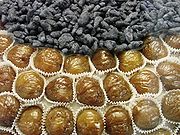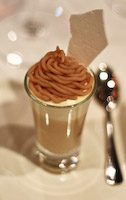
Marrons glacés
Encyclopedia

Confectionery
Confectionery is the set of food items that are rich in sugar, any one or type of which is called a confection. Modern usage may include substances rich in artificial sweeteners as well...
consisting of a chestnut
Chestnut
Chestnut , some species called chinkapin or chinquapin, is a genus of eight or nine species of deciduous trees and shrubs in the beech family Fagaceae, native to temperate regions of the Northern Hemisphere. The name also refers to the edible nuts they produce.-Species:The chestnut belongs to the...
candied in sugar syrup and glaze
Glaze (cooking technique)
A glaze in cooking is a coating of a glossy, often sweet, sometimes savoury, substance applied to food typically by dipping, dripping, or with a brush. Egg whites and basic icings are both used as glazes...
d.
History
Candied chestnuts appeared in chestnut-growing areas North of Italy and South of France, shortly after the crusaders brought sugar back with them as one result of their endeavours. Sugar allowed that which honeyHoney
Honey is a sweet food made by bees using nectar from flowers. The variety produced by honey bees is the one most commonly referred to and is the type of honey collected by beekeepers and consumed by humans...
couldn't . A candied chestnut confection was probably served around the beginning of the 15th century, among other places in Piedmont
Piedmont
Piedmont is one of the 20 regions of Italy. It has an area of 25,402 square kilometres and a population of about 4.4 million. The capital of Piedmont is Turin. The main local language is Piedmontese. Occitan is also spoken by a minority in the Occitan Valleys situated in the Provinces of...
, a northwestern area of Italy close to the border of Switzerland and France. But marrons glacés as such (with the last touch of 'glazing'), may have been created only in the 16th century. Lyon
Lyon
Lyon , is a city in east-central France in the Rhône-Alpes region, situated between Paris and Marseille. Lyon is located at from Paris, from Marseille, from Geneva, from Turin, and from Barcelona. The residents of the city are called Lyonnais....
and Cuneo
Cuneo
Cuneo is a city and comune in Piedmont, Northern Italy, the capital of the province of Cuneo, the third largest of Italy’s provinces by area...
dispute the title for the addition of the glazing, or icing, that makes the real Marron glacé.
The only certainty on the matter of dates of appearance for the recipe
Recipe
A recipe is a set of instructions that describe how to prepare or make something, especially a culinary dish.-Components:Modern culinary recipes normally consist of several components*The name of the dish...
, is that the first known records were written by French people, and that through these the marrons glacés gained their crown at the end of 17th century, in Louis XIV's Versailles court. In 1667, le Sieur François Pierre La Varenne
François Pierre La Varenne
François Pierre de la Varenne , Burgundian by birth, was the author of Le Cuisinier françois , the founding text of modern French cuisine. La Varenne broke with the Italian traditions that had revolutionized medieval French cookery in the 16th century...
, ten years' Chef de cuisine to Nicolas Chalon du Blé, Marquis of Uxelles
Uxelles
Uxelles is a commune in the Jura dEpartment in the Franche-Comté region in eastern France.- Demographics :As of the census of 1999, the population was 39.The estimate for 2004 was 55.- References :*...
(not very far from Lyon and a chestnut-producing area), and foremost figure of the Nouvelle Cuisine movement of the time, published his best-seller book Le parfaict confiturier. In it he describes “la façon de faire marron pour tirer au sec” (“the way to make (a) chestnut (so as) to 'pull it dry'”); this may well be the first record of the recipe for “marrons glacés”. “Tirer au sec” means, in a confectionery context, “to remove (what's being candied) from the syrup”. La Varenne
La Varenne
La Varenne may refer to:* La Varenne-Saint-Hilaire, a small town in the suburbs of Paris, part of the commune of Saint-Maur-des-Fossés, in France...
's book was edited thirty times in seventy-five years.
Nevertheless that book was not mentioned (nor indeed any other) when the recipe applied to cocoa beans, was in 1694 passed on to Father Jean-Baptiste Labat, a French missionary
Missionary
A missionary is a member of a religious group sent into an area to do evangelism or ministries of service, such as education, literacy, social justice, health care and economic development. The word "mission" originates from 1598 when the Jesuits sent members abroad, derived from the Latin...
in the Martinique
Martinique
Martinique is an island in the eastern Caribbean Sea, with a land area of . Like Guadeloupe, it is an overseas region of France, consisting of a single overseas department. To the northwest lies Dominica, to the south St Lucia, and to the southeast Barbados...
. In that year Father Labat wrote in a letter, of a recipe for candied and iced cocoa beans which he had tasted when dining at a M. Pocquet's.
Another early citation, still in French, is from 1690.
Towards the end of 19th century, Lyon
Lyon
Lyon , is a city in east-central France in the Rhône-Alpes region, situated between Paris and Marseille. Lyon is located at from Paris, from Marseille, from Geneva, from Turin, and from Barcelona. The residents of the city are called Lyonnais....
was brought low by the collapse of the textile market, notably silk. In the middle of an epidemic, Clément Faugier Ingénieur des ponts et chaussées, was looking for a way to revitalize the regional economy. In 1882 he and a local 'confiseur' set up in Privas
Privas
Privas is a commune of France, capital of the Ardèche department. It is the second-smallest administrative center of any department in France, larger than only the commune of Foix. It is the fifth-largest commune in the Ardèche, behind Annonay, Aubenas, Guilherand-Granges, and Tournon-sur-Rhône. It...
, Ardèche, the first factory with the technology to produce marrons glacés industrially; many of the nearly twenty steps necessary from harvest to finished product are still accomplished manually. Three years later he introduced the crème de marrons de l'Ardèche, a sweetened chestnut purée made from “marrons glacés” broken during the production process, and a touch of vanilla. (later came “Marrons au Cognac” in 1924, “Purée de Marrons Nature” in 1934, “Marrons au Naturel” in 1951, and “Marpom's” in 1994.)
Chestnut or marron
The differences between a chestnut and a marron are in the fruit structure (for its ease of peeling as well as that it better holds in one piece), the size, and the taste.Both types of fruit are covered with a pellicle
Pellicle
Pellicle may refer to:*Pellicle , a thin layer supporting the cell membrane in various protozoa*Pellicle mirror, a thin plastic membrane which may be used as a beam splitter or protective cover in optical systems...
, or membrane, which closely adheres to the fruit's flesh and which must be removed because of its astringency
Astringent
An astringent substance is a chemical compound that tends to shrink or constrict body tissues, usually locally after topical medicinal application. The word "astringent" derives from Latin adstringere, meaning "to bind fast"...
. The chestnut fruit clearly shows two cotyledon
Cotyledon
A cotyledon , is a significant part of the embryo within the seed of a plant. Upon germination, the cotyledon may become the embryonic first leaves of a seedling. The number of cotyledons present is one characteristic used by botanists to classify the flowering plants...
s usually separated with deep grooves going nearly all the way through the fruit; this makes them too fragile for the necessary manipulations during the cooking process. There also are other grooves on the surface, which means more embedded pellicle that must be painstakingly removed (although there is a trick to it). The marron does not have the separation in two cotyledon
Cotyledon
A cotyledon , is a significant part of the embryo within the seed of a plant. Upon germination, the cotyledon may become the embryonic first leaves of a seedling. The number of cotyledons present is one characteristic used by botanists to classify the flowering plants...
s; it appears in one piece and it shows few very shallow grooves. After thousands of years of breeding many varieties are also sweeter. These are the material for marrons glacés which are three or four times more expensive than the châtaigne because they also have a lower yield.
Uses

Vanilla
Vanilla is a flavoring derived from orchids of the genus Vanilla, primarily from the Mexican species, Flat-leaved Vanilla . The word vanilla derives from the Spanish word "", little pod...
, and itself a staple ingredient for other desserts, such as the Mont Blanc
Mont Blanc (dessert)
A Mont Blanc ) is a dessert of puréed, sweetened chestnuts topped with whipped cream...
(puréed with cream), ice cream
Ice cream
Ice cream is a frozen dessert usually made from dairy products, such as milk and cream, and often combined with fruits or other ingredients and flavours. Most varieties contain sugar, although some are made with other sweeteners...
s, cakes, sweet sauce or garnish for other desserts ...
In Literature and Popular Culture
In the novel La dame aux CaméliasThe Lady of the Camellias
The Lady of the Camellias is a novel by Alexandre Dumas, fils, first published in 1848, and subsequently adapted for the stage. The Lady of the Camellias premiered at the Théâtre du Vaudeville in Paris, France on February 2, 1852. The play was an instant success, and Giuseppe Verdi immediately set...
(1848) by Alexandre Dumas, fils
Alexandre Dumas, fils
Alexandre Dumas, fils was a French author and dramatist. He was the son of Alexandre Dumas, père, also a writer and playwright.-Biography:...
, marrons glacés are said to be the only type of confection that the principal character, the courtesan
Courtesan
A courtesan was originally a female courtier, which means a person who attends the court of a monarch or other powerful person.In feudal society, the court was the centre of government as well as the residence of the monarch, and social and political life were often completely mixed together...
Marguerite Gautier, would eat. Her clients were expected to buy bags of them for her to enjoy.
In the short story "Reginald" (1901) by Saki
Saki
Hector Hugh Munro , better known by the pen name Saki, and also frequently as H. H. Munro, was a British writer whose witty, mischievous and sometimes macabre stories satirised Edwardian society and culture. He is considered a master of the short story and often compared to O. Henry and Dorothy...
, the narrator leaves Reginald "near a seductive dish of marrons glacés" at a garden-party in the vain hope that these delicacies will distract him from wrecking social havoc.
In the video game Final Fantasy XI
Final Fantasy XI
, also known as Final Fantasy XI Online, is a MMORPG developed and published by Square as part of the Final Fantasy series. It was released in Japan on Sony's PlayStation 2 on May 16, 2002, and was released for Microsoft's Windows-based personal computers in November 2002...
, Marron glacé is used as mage's food, and is described as a traditional dessert of the country of San d'Oria.

